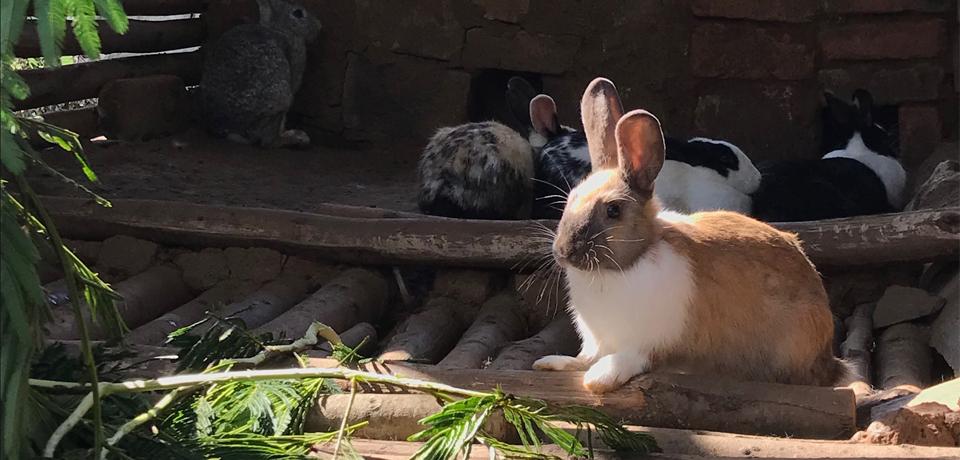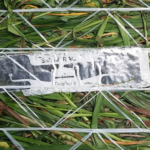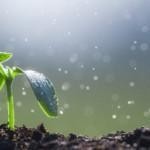
Elina Sauvola, Lenka Siskova & Satu Määttänen
Agriculture is a key component of the Ugandan economy and livelihoods, contributing to 24 percent of the country’s GDP, together with forestry and fishing, and employing 68 percent of females and 58 percent of males in the country (World Bank, 2024). Uganda used to be considered one of the Sub-Saharan African countries with the most fertile soils, but nowadays, the country suffers from one of the highest soil nutrient depletion rates in Africa. (Mugizi & Matsumoto, 2021). In Uganda, approximately 80 kg of nutrients per hectare is lost annually, while only 1–1.5 kg of nutrients per hectare is added (MAAIF & EPRC, 2016). This indicates a clear threat to Ugandan food security, economy, and livelihoods (MAAIF & EPRC, 2016).
Fertilizer input is crucial to improve Ugandan agricultural productivity (MAAIF & EPRC, 2016). Rabbit rearing and utilizing rabbit excreta as a fertilizer can contribute to improving access to fertilizers while simultaneously contributing to income generation and food security (Oseni & Lukefahr, 2014). Rabbit farming, i.e., cuniculture, is recognized as suitable for small-scale farmers – which constitutes most Ugandan farmers – as it requires low investment and poses a low economic risk (Oseni & Lukefahr, 2014), while simultaneously providing a year-round breeding season, short gestation, fast growth, and a high nutritional profile (Mailafia et al., 2010). Rabbit excreta has a high nutritional composition, offering higher nutrient and organic matter values than cattle, sheep, or poultry manure or even some commercial liquid fertilizers (Bastos et al., 2023; Mutai, 2020). Despite its currently relatively low adoption rates, research has proven rabbit urine’s benefits on yields of various crops, such as tomato (Indabo & Abubakar, 2020), cucumber (Okonji et al., 2023), and bok choy (Kurnianta et al., 2021). Additionally, rabbit urine can be used as a biopesticide against pathogens and pests such as aphids or fall armyworms (Kemunto et al., 2022).
Due to its various benefits, rabbit rearing, and rabbit excreta utilization as fertilizer could increase the use of organic fertilizers, thus replenishing the soils and improving food security in Uganda. This article investigates the use of rabbit urine as a fertilizer among small-scale farmers in Mbarara, Uganda, focusing on the current levels of usage, usage methods, and challenges relating to rabbit rearing and urine usage as a fertilizer. Understanding these is crucial for assessing the feasibility of rabbit urine as a solution to soil nutrient depletion in Ugandan smallholder farms and providing recommendations on how to promote and enhance rabbit urine’s usage as a fertilizer.
Materials and methods
As part of the EU-funded AgriSCALE project (www.agriscale.net), a student challenge was organized in Uganda in April 2023 to learn about and assess different organic fertilizers and their use. Student challenge is a learning concept where student teams learn by working with authentic cases or by solving real-life problems (Määttänen et al., 2022). The two first authors of this article participated in the “organic fertilizer” student challenge as part of a multicultural and -disciplinary team consisting of members from four universities (Häme University of Applied Sciences in Finland, Bishop Stuart University, and Gulu University in Uganda, and Jomo Kenyatta University of Agriculture and Technology in Kenya). The team’s specific working focus was on rabbit urine as an organic fertilizer, and this article utilizes data collected during the challenge.
The data was collected in April 2023 in the Mbarara district, southwest Uganda. In the district, around 60 percent of the population lives in rural areas (Uganda Bureau of Statistics, 2022). The main crops in the area include bananas, beans, and maize, while cattle farming dominates the livestock sector (E.B. Tumusiime, personal communication 1.2.2023). The majority of the local farmers are smallholder subsistence farmers. These farmers lack the resources and knowledge to access organic fertilizers (E. B. Tumusiime, personal communication, March 6, 2023).
Five farming sites were selected by the challenge organizer, Bishop Stuart University, to act as conveners and a gathering place. The contact persons of the farming sites invited nearby farmers to their premises to participate in interviews about using rabbit urine as a fertilizer. A total of 27 persons, ten females and 17 males, were interviewed using a semi-structured questionnaire. Most of the interviewees were local farmers, but 8 of them were students from local agricultural schools. These students were advised to answer the questionnaire as “professional farmers,” i.e., their answers may reflect farming methods they implement at their farms or their plots at the institute. The questionnaires used in the interview were reviewed by local students and tested during the first farm visit, resulting in slight modifications. The interviews were conducted either in English or in local languages, with local students acting as interpreters.
A descriptive analysis, using Microsoft Excel (Version 2310, 16.0.16924.2005), was used to analyze the data. Due to sampling bias, gender was not considered in the data analysis, and we did not use descriptive variables.
Results
Of the 27 interviewed farmers, 37.0 percent were under the age of 30 (young), 37.0 percent were between 30 and 50 years old (middle-aged), and 26.0 percent were over 50 years of age (senior). The highest obtained education level of the interviewees varied from primary school (33.3 % of respondents), secondary school (18.5 %), national certificate (29.6 %), and higher education (diploma, bachelor’s degree, master’s degree, 14.8 %). Farm sizes of the interviewed farmers varied from 0.1 to 81 hectares, with a median of 0.61 hectares. Using the FAO (2012) definition of small-scale farmers managing up to 10 hectares of land, 26 of the interviewed farmers were smallholders, and only one was not. The most commonly grown crops were bananas, cabbage, beans, tomatoes, and amaranth. Of the 27 interviewed farmers, only two measured the pH of their soil, and the remaining 92.6 percent either did not analyze the soil at all or used only visual analysis of the soil or the crop.
Of the interviewed farmers, 14 were rearing rabbits, with the number of rabbits per farm varying from 4 to up to 250 rabbits, with a median of 15 rabbits. Altogether, 17 (63.0 %) of the interviewed farmers, ten male and seven female, used rabbit urine as a fertilizer. Out of the 17 farmers using rabbit urine as a fertilizer, 12 were themselves rearing rabbits.
Using rabbit urine as fertilizer was more common among the young farmers as compared to the older age groups (Figure 1), with 80.0 percent of young farmers using rabbit urine as fertilizer, in contrast to 66.7 percent among the middle-aged and 37.5 percent among the senior farmers. Using rabbit urine as a fertilizer was also more common among the farmers with higher levels of education. 75.0 percent of farmers with a diploma, a national certificate, bachelor’s or master’s level of education used rabbit urine as a fertilizer, whereas 53.3 percent of farmers with just primary or secondary education used it. However, these results were due to the selection of the interviewed farmers. All the young farmers had an educational level higher than primary or secondary school, and 90.0 percent of the young farmers were students at agricultural schools. These students most likely have access to agricultural information, including organic fertilizers, and their respective institutions may promote the usage of rabbit urine as a fertilizer. Due to this selection bias, the results on age and education level reflect more the situation in the specific educational institutions than the actual rural setting in the region.

Farm size did not seem to influence the usage of rabbit urine as a fertilizer. The farm sizes of farmers using rabbit urine as a fertilizer varied from 0.1 to 81.0 hectares (median 0.4 ha), and the farm sizes of non-users varied between 0.3 and 3.2 hectares (median 0.8 ha). The time farmers had been using rabbit urine varied from only three months to seven years, with the average being one year and eight months.
Only the farmers using rabbit urine as fertilizer (n=17) were asked additional questions regarding application and storage.
Half of the 17 respondents used foliar application, i.e., applying the fertilizer in a liquid form directly to plant leaves, and another half used direct application, i.e., applying the fertilizer to soil. One farmer used both methods depending on the crop.
The application interval was, on average, two weeks and five days, with the shortest interval being one week and the longest 12 weeks. Five farmers didn’t answer the question of application interval, as the questionnaire was edited after the first round of interviews and the question of application was added in the editing process.
Plastic containers were the only recorded storage method, with 100 percent recurrence. The storage interval, however, differed substantially, with the longest interval being 12 weeks and the shortest being none, suggesting an immediate application. On average, the storage interval was two weeks and six days, with two weeks being the most frequent answer.
There was no relation between the length of storage and application interval, i.e., a longer storage level was not associated with a longer application interval or the other way around. The irregularities between the two may be explained by several factors, for instance, lack of understanding of the question, approximate or incorrect answers, or wrong question formulation.
All interviewed farmers were inquired about challenges related to rabbit rearing and rabbit urine usage as a fertilizer. 20 (74.1 %) farmers mentioned at least one challenge. Seven farmers, of which five didn’t use rabbit urine as a fertilizer, did not mention any challenge (Figure 2)

Seven farmers answered lack of information as a challenge, four of those being farmers that did not use rabbit urine as a fertilizer. Information was lacking, especially on rabbit rearing, urine collection, and urine application methods.
Another common challenge was the collection of rabbit excreta, which was mentioned by seven farmers, who all used rabbit urine as a fertilizer. Challenges in collection were mentioned irrespective of farm size or number of reared rabbits.
Five farmers mentioned rabbit diseases as a challenge, with four of them being rabbit rearers and one not. Farmers mentioned struggling with rabbit diseases, which would suddenly appear and wipe out the entire herd, with farmers having no information to prevent, diagnose, or treat the diseases.
Three of the nine farmers applying rabbit urine as a foliar fertilizer saw application as a challenge since it caused scorching and rotting crops.
Other challenges mentioned by the interviewed farmers were lack of equipment (three respondents), insufficient amount of urine (two respondents), storage and management of urine (two respondents), time-consuming and laborious nature of rabbit urine usage (one respondent), small number of rabbits (one respondent), and predators and cold conditions (one respondent) and structure (one respondent).
Discussion
Research design
The purposeful selection of the farms and the interviewed farmers was not an optimal sampling design. Two of the farm sites are educational institutions, and eight of the interviewees are students of these institutions, which caused a selection bias, i.e., the real situation in the region is not accurately represented. The students were overrepresented in the young age groups and in higher educational levels, and thus, age or educational level were not used as descriptive variables. In addition, significant gender bias occurred, as two-thirds of the interviewees were male. Consequently, gender was not considered during data analysis.
The interviews and the questionnaire contained caveats. More comprehensive testing and refining of the interview questionnaire could have prevented several inconsistencies in the data, such as not having full interviews from the first location, as some questions were added afterward. A more comprehensive and well-planned questionnaire form would also have allowed detailed data analysis and interpretation. Some questions might have been misunderstood, which could explain the inconsistencies between the storage period and application interval. Additionally, different team members conducting the interviews were less or more careful not to lead respondents to certain answers. Training and/or sensitizing to interview techniques and ethical guidelines would have most likely yielded more consistent interviews and, thus, better-quality data.
Usage of rabbit urine as a fertilizer
Of the 17 farmers that used rabbit urine as a fertilizer, 12 reared rabbits. Most fertilizers used by small-scale farmers in Mbarara district come from self-sufficient sources. Using animal manure as a fertilizer is especially common, i.e., owning domestic animals has a direct effect on the availability of fertilizers. It is, thus, logical that farmers owning rabbits, regardless of the size of the herd, use rabbit urine more commonly than farmers not owning rabbits. This indicates that promoting rabbit rearing could be a considerable measure to provide food and/or income sources but also increase the availability of organic fertilizers to small-scale farmers. The study showed that some farmers who do not rear rabbits still find rabbit urine so important fertilizer that they source it elsewhere. On the other hand, two respondents who reared rabbits did not use rabbit urine as a fertilizer. The research failed to provide a reason for this, but the reason was not due to the size of the farm or the number of reared rabbits. For enhancing rabbit urine usage as an organic fertilizer, it would be important to study this further to investigate in detail what the factors enhancing or impeding the usage of rabbit urine as a fertilizer are.
The study did not find any relationship between storage period and application interval, or between farm size or number of rabbits and the storage interval. The large variation in the application interval of rabbit urine as a fertilizer can be due to different crops cultivated, varying availability and usage of other fertilizers, lack of knowledge and established guidelines on the optimal application interval, or a combination of these factors.
The majority of the interviewed farmers did not test or analyze their soil and its properties in laboratories, indicating that fertilizer requirement is based on visual assessment, assumptions, or practical experience. This may affect the fertilizer application and its interval, as the exact amount of needed fertilizer input cannot be known or monitored. Although soil analysis was found not to be prevalent in the region, it is unclear whether this method would be more viable for the typical small-scale farmer compared to indigenous and experience-based farming knowledge.
Challenges in utilizing rabbit urine
Lack of knowledge and information inhibits the usage of rabbit urine as a fertilizer. Lack of knowledge was directly mentioned as a challenge by farmers, but it also underpinned many of the other challenges perceived. Access to information and subsequent changes in application and rearing practices can, for example, help to overcome the challenges related to the scorching of crops and the prevalence and treatment of rabbit diseases.
Proper information and modern rearing and urine usage methods can reduce the laboriousness of rabbit urine collection, which was perceived as a challenge by several farmers. The structure of the rabbit housing system depends, of course, on the number of rabbits, resources available, and the main purpose of rearing, but to favor the collection of urine and feces and to decrease the risk of diseases, there are specific structures that can be used. Rabbit cages with wire-mesh flooring placed above each other with a sloping metal sheet and a gutter underneath are affordable and easily manageable structures that ease the removal of droppings and help avoid respiratory diseases and injuries (Lebas et al., 1986). Although this kind of rabbit housing system was observed at some of the visited farms, its adoption was not prevalent.
To make rabbit rearing and rabbit excreta-based fertilization a compelling and reliable option for farmers, access to information needs to be improved. The information would be needed on, among others, rabbit diseases, their prevention and treatment, the collection and processing methods of rabbit urine, feasible storage, and application methods, including interval periods. Researchers play a crucial role in producing the information, and extension workers are pivotal in bringing this knowledge to farmers. The cooperation and information flow between these actors need to be strengthened. In addition, we suggest producing and distributing a leaflet illustration paper containing basic information about rabbit rearing, housing, breeding, and feeding.
Conclusions
Soil nutrient depletion is a major challenge for Ugandan smallholder-driven agriculture. Rabbit farming and the use of rabbit excreta as a fertilizer can be one of the solutions to this challenge.
Rabbit urine is already used as a fertilizer in the Mbarara district in Uganda, with many of the interviewed farmers possessing some degree of knowledge and expertise in rabbit farming and excreta-based fertilizing. Rabbit urine is used as fertilizer among different farm sizes and with a variable number of rabbit herds.
Yet, especially, lack of knowledge hinders the adoption of rabbit rearing and the usage of rabbit urine as a fertilizer. To up-scale the practice of using rabbit urine to fertilize the nutrient-poor soils of Uganda, farmers need to be provided with knowledge and skills related to rabbit rearing and urine collecting, processing, and application.
Authors
Elina Sauvola, Bachelor of Natural Resources (Sustainable Development) from the Häme University of Applied Sciences.
Lenka Siskova, Bachelor of Natural Resources (Climate Smart Agriculture) from the Häme University of Applied Sciences.
Satu Määttänen, M.Sc. in Agricultural Sciences and M.Sc. in Environmental Science and Policy from the University of Helsinki. She works as a project expert at the HAMK Bio Research Unit.
References
Bastos, F. E. A., Ribeiro, S. B., Borba, A. F., Campos, L. T., Fincatto, D., & Bertoli, C. D. (2023). Use of rabbit manure in lettuce culture: an alternative option. Horticultura Brasileira, 40(4), 367–372. https://doi.org/10.1590/S0102-0536-20220403
FAO. (2012). Smallholders and Family Farmers. https://www.fao.org/family-farming/detail/en/c/273864/
Indabo, S., & Abubakar, A. A. (2020). Effect of Rabbit Urine Application Rate as a BioFertilizer on Agro-Mophorlogical Traits Of UC82B Tomato (Lycopersicon Esculentum Mill) Variety in Zaria, Nigeria. Dutse Journal of Pure and Applied Sciences, 6(2), 344–352.
Kemunto, D., Omuse, E. R., Mfuti, D. K., Tamiru, A., Hailu, G., Rwiza, I., Belayneh, Y. T., Subramanian, S., & Niassy, S. (2022). Effect of Rabbit Urine on the Larval Behavior, Larval Mortality, Egg Hatchability, Adult Emergence and Oviposition Preference of the Fall Armyworm (Spodoptera frugiperda J.E. Smith). Agriculture 2022, 12(8), 1282. https://doi.org/10.3390/AGRICULTURE12081282
Kurnianta, L. D., Sedijani, P., & Raksun, A. (2021). The Effect of Liquid Organic Fertilizer (LOF) Made from Rabbit Urine and NPK Fertilizer on the Growth of Bok Choy (Brassica rapa L. Subsp. chinensis). Jurnal Biologi Tropis, 21(1), 157–170. https://doi.org/10.29303/JBT.V21I1.2426
Lebas, F., Coudert, P., Rouvier, R., & de Rochambeau, H. (1986). The rabbit husbandry, health and production. FAO Animal Production and Health Series, no. 21. https://www.fao.org/3/x5082e/X5082E00.htm
MAAIF, & EPRC. (2016). National Fertilizer Policy – Uganda. https://doi.org/10.22004/ag.econ.257813
Määttänen, S., Knuutti, U.-M., & Laitinen, E. (2022). Piloting international student challenges: results on students’ perspective. HAMK Unlimited Professional, 26.9.2022. https://urn.fi/URN:NBN:fi-fe2022062047869
Mailafia, S., Onakpa, M., & Owoleke, O. (2010). Problems and prospects of rabbit production in Nigeria – a review. Bayero Journal of Pure and Applied Sciences, 3(2), 20–25. https://doi.org/10.4314/BAJOPAS.V3I2.63213
Mugizi, F. M. P., & Matsumoto, T. (2021). A curse or a blessing? Population pressure and soil quality in Sub-Saharan Africa: Evidence from rural Uganda. Ecological Economics, 179, 106851. https://doi.org/10.1016/J.ECOLECON.2020.106851
Mutai, P. A. (2020). The Potential Use of Rabbit Urine as a Bio Fertilizer Foliar Feed in Crop Production. Africa Environmental Review Journal, 4(1), 138–147. https://doi.org/10.2200/AERJ.V4I1.122
Okonji, C. J., Ajayi, E. O., Obisesan, O. I., Osundare, O. T., & Adetuyi, A. O. (2023). PERFORMANCE OF RABBIT URINE ON THE YIELD AND YIELD COMPONENT OF CUCUMBER. BADEGGI JOURNAL OF AGRICULTURAL RESEARCH AND ENVIRONMENT, 5(1), 15–23. https://doi.org/10.35849/BJARE202301/81/002
Oseni, S. O., & Lukefahr, S. D. (2014). Rabbit production in low-input systems in Africa: situation, knowledge and perspectives – A review. World Rabbit Science, 22(2), 147–160. https://doi.org/10.4995/WRS.2014.1348
Uganda Bureau of Statistics. (2022). Rural Urban Population for the 146 Districts in Uganda. Population & Censuses. https://www.ubos.org/explore-statistics/20/
World Bank. (2024). World Bank Open Data. The World Bank Group. https://data.worldbank.org/





